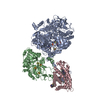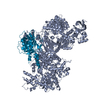[English] 日本語
 Yorodumi
Yorodumi- PDB-7px3: Structure of U5 snRNP assembly and recycling factor TSSC4 in comp... -
+ Open data
Open data
- Basic information
Basic information
| Entry | Database: PDB / ID: 7px3 | ||||||
|---|---|---|---|---|---|---|---|
| Title | Structure of U5 snRNP assembly and recycling factor TSSC4 in complex with BRR2 and Jab1 domain of PRPF8 | ||||||
 Components Components |
| ||||||
 Keywords Keywords |  SPLICING / Spliceosomal biogenesis SPLICING / Spliceosomal biogenesis | ||||||
| Function / homology |  Function and homology information Function and homology informationcis assembly of pre-catalytic spliceosome / spliceosome conformational change to release U4 (or U4atac) and U1 (or U11) / molecular sequestering activity / U2-type catalytic step 1 spliceosome /  RNA splicing, via transesterification reactions / U2-type precatalytic spliceosome / U2-type catalytic step 2 spliceosome / K63-linked polyubiquitin modification-dependent protein binding / mRNA Splicing - Minor Pathway / spliceosomal tri-snRNP complex assembly ...cis assembly of pre-catalytic spliceosome / spliceosome conformational change to release U4 (or U4atac) and U1 (or U11) / molecular sequestering activity / U2-type catalytic step 1 spliceosome / RNA splicing, via transesterification reactions / U2-type precatalytic spliceosome / U2-type catalytic step 2 spliceosome / K63-linked polyubiquitin modification-dependent protein binding / mRNA Splicing - Minor Pathway / spliceosomal tri-snRNP complex assembly ...cis assembly of pre-catalytic spliceosome / spliceosome conformational change to release U4 (or U4atac) and U1 (or U11) / molecular sequestering activity / U2-type catalytic step 1 spliceosome /  RNA splicing, via transesterification reactions / U2-type precatalytic spliceosome / U2-type catalytic step 2 spliceosome / K63-linked polyubiquitin modification-dependent protein binding / mRNA Splicing - Minor Pathway / spliceosomal tri-snRNP complex assembly / RNA splicing, via transesterification reactions / U2-type precatalytic spliceosome / U2-type catalytic step 2 spliceosome / K63-linked polyubiquitin modification-dependent protein binding / mRNA Splicing - Minor Pathway / spliceosomal tri-snRNP complex assembly /  U5 snRNA binding / U5 snRNP / U5 snRNA binding / U5 snRNP /  U2 snRNA binding / spliceosomal snRNP assembly / U2 snRNA binding / spliceosomal snRNP assembly /  U6 snRNA binding / pre-mRNA intronic binding / U6 snRNA binding / pre-mRNA intronic binding /  U1 snRNA binding / U4/U6 x U5 tri-snRNP complex / catalytic step 2 spliceosome / mRNA Splicing - Major Pathway / U1 snRNA binding / U4/U6 x U5 tri-snRNP complex / catalytic step 2 spliceosome / mRNA Splicing - Major Pathway /  RNA splicing / RNA splicing /  helicase activity / helicase activity /  spliceosomal complex / spliceosomal complex /  mRNA splicing, via spliceosome / mRNA splicing, via spliceosome /  mRNA processing / osteoblast differentiation / cellular response to tumor necrosis factor / cellular response to lipopolysaccharide / mRNA processing / osteoblast differentiation / cellular response to tumor necrosis factor / cellular response to lipopolysaccharide /  RNA helicase activity / RNA helicase activity /  RNA helicase / nuclear speck / protein-containing complex binding / RNA helicase / nuclear speck / protein-containing complex binding /  ATP hydrolysis activity / ATP hydrolysis activity /  RNA binding / RNA binding /  nucleoplasm / nucleoplasm /  ATP binding / ATP binding /  membrane / identical protein binding / membrane / identical protein binding /  nucleus / nucleus /  cytoplasm cytoplasmSimilarity search - Function | ||||||
| Biological species |   Homo sapiens (human) Homo sapiens (human) | ||||||
| Method |  ELECTRON MICROSCOPY / ELECTRON MICROSCOPY /  single particle reconstruction / single particle reconstruction /  cryo EM / Resolution: 3.05 Å cryo EM / Resolution: 3.05 Å | ||||||
 Authors Authors | Bergfort, A. / Kuropka, B. / Ilik, I.A. / Freund, C. / Aktas, T. / Hilal, T. / Weber, G. / Wahl, M.C. | ||||||
| Funding support |  Germany, 1items Germany, 1items
| ||||||
 Citation Citation |  Journal: Nucleic Acids Res / Year: 2022 Journal: Nucleic Acids Res / Year: 2022Title: The intrinsically disordered TSSC4 protein acts as a helicase inhibitor, placeholder and multi-interaction coordinator during snRNP assembly and recycling. Authors: Alexandra Bergfort / Tarek Hilal / Benno Kuropka / İbrahim Avşar Ilik / Gert Weber / Tuğçe Aktaş / Christian Freund / Markus C Wahl /  Abstract: Biogenesis of spliceosomal small nuclear ribonucleoproteins (snRNPs) and their recycling after splicing require numerous assembly/recycling factors whose modes of action are often poorly understood. ...Biogenesis of spliceosomal small nuclear ribonucleoproteins (snRNPs) and their recycling after splicing require numerous assembly/recycling factors whose modes of action are often poorly understood. The intrinsically disordered TSSC4 protein has been identified as a nuclear-localized U5 snRNP and U4/U6-U5 tri-snRNP assembly/recycling factor, but how TSSC4's intrinsic disorder supports TSSC4 functions remains unknown. Using diverse interaction assays and cryogenic electron microscopy-based structural analysis, we show that TSSC4 employs four conserved, non-contiguous regions to bind the PRPF8 Jab1/MPN domain and the SNRNP200 helicase at functionally important sites. It thereby inhibits SNRNP200 helicase activity, spatially aligns the proteins, coordinates formation of a U5 sub-module and transiently blocks premature interaction of SNRNP200 with at least three other spliceosomal factors. Guided by the structure, we designed a TSSC4 variant that lacks stable binding to the PRPF8 Jab1/MPN domain or SNRNP200 in vitro. Comparative immunoprecipitation/mass spectrometry from HEK293 nuclear extract revealed distinct interaction profiles of wild type TSSC4 and the variant deficient in PRPF8/SNRNP200 binding with snRNP proteins, other spliceosomal proteins as well as snRNP assembly/recycling factors and chaperones. Our findings elucidate molecular strategies employed by an intrinsically disordered protein to promote snRNP assembly, and suggest multiple TSSC4-dependent stages during snRNP assembly/recycling. | ||||||
| History |
|
- Structure visualization
Structure visualization
| Movie |
 Movie viewer Movie viewer |
|---|---|
| Structure viewer | Molecule:  Molmil Molmil Jmol/JSmol Jmol/JSmol |
- Downloads & links
Downloads & links
- Download
Download
| PDBx/mmCIF format |  7px3.cif.gz 7px3.cif.gz | 383.9 KB | Display |  PDBx/mmCIF format PDBx/mmCIF format |
|---|---|---|---|---|
| PDB format |  pdb7px3.ent.gz pdb7px3.ent.gz | 297.4 KB | Display |  PDB format PDB format |
| PDBx/mmJSON format |  7px3.json.gz 7px3.json.gz | Tree view |  PDBx/mmJSON format PDBx/mmJSON format | |
| Others |  Other downloads Other downloads |
-Validation report
| Arichive directory |  https://data.pdbj.org/pub/pdb/validation_reports/px/7px3 https://data.pdbj.org/pub/pdb/validation_reports/px/7px3 ftp://data.pdbj.org/pub/pdb/validation_reports/px/7px3 ftp://data.pdbj.org/pub/pdb/validation_reports/px/7px3 | HTTPS FTP |
|---|
-Related structure data
| Related structure data |  13690MC  7os1C  7os2C M: map data used to model this data C: citing same article ( |
|---|---|
| Similar structure data |
- Links
Links
- Assembly
Assembly
| Deposited unit | 
|
|---|---|
| 1 |
|
- Components
Components
| #1: Protein | Mass: 199666.656 Da / Num. of mol.: 1 Source method: isolated from a genetically manipulated source Source: (gene. exp.)   Homo sapiens (human) / Gene: SNRNP200, ASCC3L1, HELIC2, KIAA0788 / Production host: Homo sapiens (human) / Gene: SNRNP200, ASCC3L1, HELIC2, KIAA0788 / Production host:   Trichoplusia ni (cabbage looper) / References: UniProt: O75643, Trichoplusia ni (cabbage looper) / References: UniProt: O75643,  RNA helicase RNA helicase |
|---|---|
| #2: Protein | Mass: 30133.229 Da / Num. of mol.: 1 Source method: isolated from a genetically manipulated source Source: (gene. exp.)   Homo sapiens (human) / Gene: PRPF8, PRPC8 / Production host: Homo sapiens (human) / Gene: PRPF8, PRPC8 / Production host:   Trichoplusia ni (cabbage looper) / References: UniProt: Q6P2Q9 Trichoplusia ni (cabbage looper) / References: UniProt: Q6P2Q9 |
| #3: Protein | Mass: 34366.465 Da / Num. of mol.: 1 Source method: isolated from a genetically manipulated source Source: (gene. exp.)   Homo sapiens (human) / Gene: TSSC4 / Production host: Homo sapiens (human) / Gene: TSSC4 / Production host:   Escherichia coli BL21(DE3) (bacteria) / References: UniProt: Q9Y5U2 Escherichia coli BL21(DE3) (bacteria) / References: UniProt: Q9Y5U2 |
-Experimental details
-Experiment
| Experiment | Method:  ELECTRON MICROSCOPY ELECTRON MICROSCOPY |
|---|---|
| EM experiment | Aggregation state: PARTICLE / 3D reconstruction method:  single particle reconstruction single particle reconstruction |
- Sample preparation
Sample preparation
| Component |
| ||||||||||||||||||||||||||||||
|---|---|---|---|---|---|---|---|---|---|---|---|---|---|---|---|---|---|---|---|---|---|---|---|---|---|---|---|---|---|---|---|
| Molecular weight |
| ||||||||||||||||||||||||||||||
| Source (natural) |
| ||||||||||||||||||||||||||||||
| Source (recombinant) |
| ||||||||||||||||||||||||||||||
| Buffer solution | pH: 7.6 | ||||||||||||||||||||||||||||||
| Specimen | Conc.: 5 mg/ml / Embedding applied: NO / Shadowing applied: NO / Staining applied : NO / Vitrification applied : NO / Vitrification applied : YES : YES | ||||||||||||||||||||||||||||||
Vitrification | Instrument: FEI VITROBOT MARK IV / Cryogen name: ETHANE / Humidity: 100 % / Chamber temperature: 308 K |
- Electron microscopy imaging
Electron microscopy imaging
| Experimental equipment |  Model: Titan Krios / Image courtesy: FEI Company |
|---|---|
| Microscopy | Model: FEI TITAN KRIOS |
| Electron gun | Electron source : :  FIELD EMISSION GUN / Accelerating voltage: 300 kV / Illumination mode: FLOOD BEAM FIELD EMISSION GUN / Accelerating voltage: 300 kV / Illumination mode: FLOOD BEAM |
| Electron lens | Mode: BRIGHT FIELD Bright-field microscopy / Nominal magnification: 120000 X / Nominal defocus max: 2000 nm / Nominal defocus min: 800 nm / Cs Bright-field microscopy / Nominal magnification: 120000 X / Nominal defocus max: 2000 nm / Nominal defocus min: 800 nm / Cs : 2.7 mm / C2 aperture diameter: 50 µm / Alignment procedure: ZEMLIN TABLEAU : 2.7 mm / C2 aperture diameter: 50 µm / Alignment procedure: ZEMLIN TABLEAU |
| Specimen holder | Cryogen: NITROGEN / Specimen holder model: FEI TITAN KRIOS AUTOGRID HOLDER |
| Image recording | Average exposure time: 30.59 sec. / Electron dose: 40 e/Å2 / Detector mode: COUNTING / Film or detector model: FEI FALCON III (4k x 4k) / Num. of grids imaged: 1 / Num. of real images: 3349 |
- Processing
Processing
| Software |
| ||||||||||||||||||||||||
|---|---|---|---|---|---|---|---|---|---|---|---|---|---|---|---|---|---|---|---|---|---|---|---|---|---|
| EM software |
| ||||||||||||||||||||||||
CTF correction | Type: PHASE FLIPPING AND AMPLITUDE CORRECTION | ||||||||||||||||||||||||
| Particle selection | Num. of particles selected: 1025529 | ||||||||||||||||||||||||
| Symmetry | Point symmetry : C1 (asymmetric) : C1 (asymmetric) | ||||||||||||||||||||||||
3D reconstruction | Resolution: 3.05 Å / Resolution method: FSC 0.143 CUT-OFF / Num. of particles: 387973 / Symmetry type: POINT | ||||||||||||||||||||||||
| Refinement | Cross valid method: NONE Stereochemistry target values: GeoStd + Monomer Library + CDL v1.2 | ||||||||||||||||||||||||
| Displacement parameters | Biso mean: 115.8 Å2 | ||||||||||||||||||||||||
| Refine LS restraints |
|
 Movie
Movie Controller
Controller











 PDBj
PDBj






